What you need to know about doors and how to choose interior doors
In our time of high technology, interior doors are still relevant. But modern products differ in many ways. Both in terms of quality, design and materials of manufacture. The question of how to correctly assess the existing diversity and how to choose interior doors remains one of the priorities in the repair.
To understand what to choose, you need to clearly understand what the doors are for, what functions they will perform in the home, what material they should be made of, what design and design are more suitable for the apartment. To do this, you need to know what requirements may be imposed on them, and what interior doors are in general. In this matter, the advice of professionals is very important.
Requirements for interior doors
The cumulative list of requirements looks like this:
- The beauty.
- Functionality.
- Reliability and durability.
Doors should be beautiful, work easily, last long and properly divide the living space. If they are glazed - let in the right amount of light.
The level of heat and sound insulation should provide a good rest. Properly installed, good sealant and nut help to solve the problem. The reliability of the door is determined by the following properties:
- Resistant to mechanical stress. Elements should not be easily scratched or peeled off after wet cleaning.
- Moisture resistance. The material must provide long-term exposure to steam without changing the physical and geometric parameters.
- UV resistant. Under the action of sunlight, the canvas and platbands burn out or change colors. The highest quality products retain their original appearance for a long time.
Construction types
If you choose the right design, it can last a long time. And there are plenty to choose from:
- Shield. Such a canvas consists of a solid material, as a rule, solid wood. Glued or whole, but with a homogeneous structure.
- Paneled. This is a type-setting structure, consisting of vertical and peppered bars and panels (thinner inserts) that form a cellular structure.
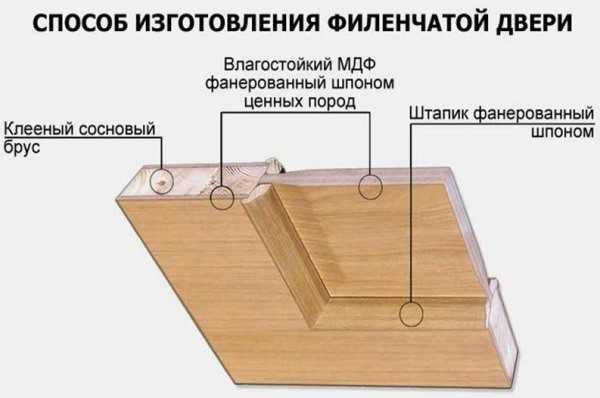
From above, MDF or chipboard plates are attached to it, for the lining of which veneer, eco-veneer or laminate is used.
According to the form, interior products are divided into the following:
- Deaf. The canvas is made entirely of one material without cutouts.
- With inserts. Cutouts are made in the canvas for inserts, which ensure that the interior space is filled with light. It is not difficult to choose an insert of any color for the interior today.
Also, the designs differ in the ways of opening. The most commonly used types are:
- Swing. These are the most ordinary doors, the wings of which are hung on hinges. There are single and double doors.
- Sliding. The sashes of these are shifted to the sides on rollers along special skids.
- Folding. This type is a construction of the "accordion" type, when the canvas folds when opened, and straightens when closed.
Material for interior doors
The material from which the product is made is a fundamental factor when choosing. It affects properties and reliability. It depends on the cost of the door. The most common are:
- Wood. Natural material is always in price due to its properties. Products from the massif differ in external beauty, durability and durability. The best models give status, significantly decorating the interior. They serve up to 50 years. They breathe, that is, provide normal moisture exchange, do not harm health and are best suited for living quarters.
- MDF. The material is an excellent alternative to natural wood. MDF boards are made from small wood shavings by pressing.
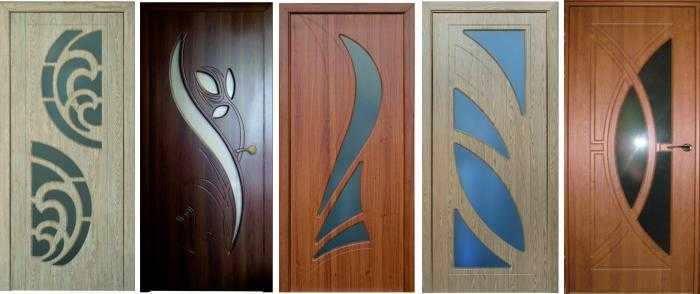
Due to the high environmental friendliness and durability, a large selection of textures and colors, MDF products enjoy a deservedly high reputation.
It is important to consider the thickness of the plates and the quality of their coating.
- Chipboard. Cheaper in the literal and figurative sense of the material. Under the condition of high-quality processing, it can serve as an alternative when choosing. It is not recommended for installation in bathrooms, toilets and kitchens, as it does not withstand high humidity.
- Plastic. Metal-plastic products are highly moisture resistant. The choice of color is small. They are not used as interrooms, but for balconies it is an indispensable option.
- Glass. Most often used as inserts, but sometimes designers recommend installing all-glass structures.
Finishes
The quality of the finish determines the appearance and durability of the door. It is on the finish that the first attention is drawn when choosing. The following materials are widely used today:
- Natural veneer. Veneered products are a great alternative to solid wood designs. Veneered doors are cheaper, and in terms of properties they are not inferior to solid wood ones. The veneer is used to cover products, both from solid wood and paneled from MDF. Veneer is environmentally friendly, and veneered doors are durable and natural beauty.
- Ecoveneer. Even more affordable modern material. It is made from wood waste with a small addition of non-natural ingredients. In the production, wood fibers are used, glued together with a special composition. Outside, the eco-veneer is covered with compounds that increase its strength and wear-resistant properties. The doors veneered by him are distinguished by a large selection of colors and textures.
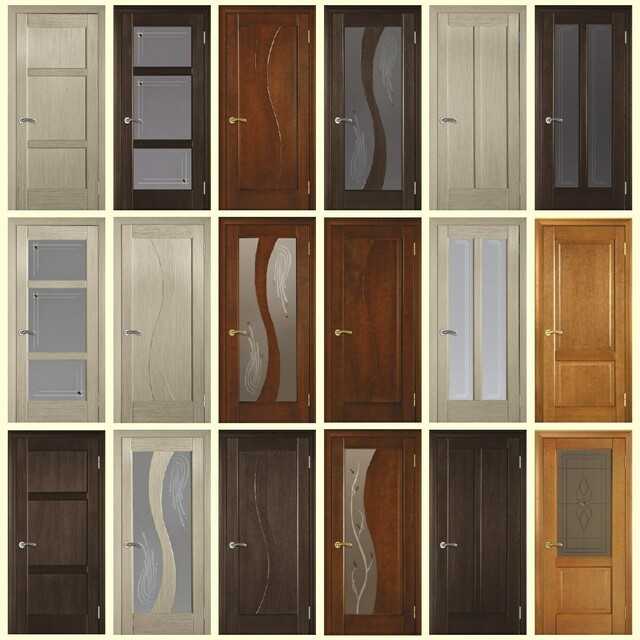
- PVC film. MDF and chipboard are covered with a polyvinyl chloride film using a special technology. Laminated PVC products have high moisture resistance and strength. PVC film completely imitates expensive types of wood. The best laminated PVC doors are outwardly difficult to distinguish from wooden ones. Laminated PVC doors are distinguished by a large selection of colors. The best laminated products with PVC film do not emit harmful substances when heated. PVC will not fade. PVC-coated laminated doors do not dry out. PVC film resists the growth of bacteria.
- Laminate. Most of the time it's an unnatural finish. The best laminated samples have a protective layer of melamine.
Veneer and eco-veneer: pros and cons
The veneer easily copes with fluctuations in humidity and temperature. If it is varnished, it is completely protected from negative factors.
Veneer provides a wide choice for design fantasy. Thanks to a large selection of textures, patterns and colors, you can choose a product for any interior. Veneer - a thin cut of wood - has all the advantages of natural wood. This is beauty, environmental friendliness, strength and durability. Veneered products also have disadvantages, which include the following:
- Veneer does not like sunlight. Under the influence of ultraviolet light, the material tarnishes.
- Insufficient moisture resistance. Thin veneer can pick up moisture and move away from the base in case of poor assembly.
Eco-veneer completely imitates it, but thanks to the added resins it is distinguished by increased strength and moisture resistance. At the same time, its cost is significantly lower.
It is almost impossible to distinguish veneered doors from natural ones either by sight or by touch.
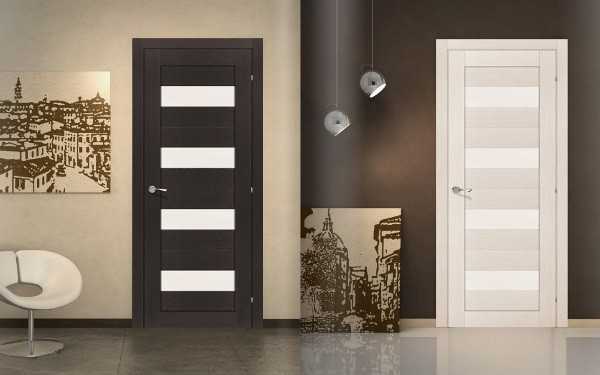
Ecoveneer has the following advantages:
- High moisture resistance. It does not absorb moisture, and therefore does not swell or dry out. Ecoveneer can be used in kitchens and bathrooms.
- Ease. The material has a relatively small mass. Such products are easier to install and require less effort in terms of ensuring the reliability of canopies.
- UV resistant. The sun does not affect this material in any way.
- Wear resistance. This property is acquired due to a special protective film that provides protection against abrasion.
- Strength. Ecoveneer is less prone to chipping and cracking.
Thanks to the last three properties, eco-veneer has durability. A large selection of textures and colors predetermines the growing popularity of the material. The disadvantages include the following:
- Low soundproofing properties.
- Ecoveneer does not breathe. The material does not allow air to pass through and does not absorb or release moisture.
- Difficulty in repairing mechanical damage.
Main selection criteria
Before choosing a door, you need to decide what functional load the structure will carry and where it will be installed. It can be just a division of living space and interior decoration, an increase in sound insulation, or all together. You need to decide how much light it should let into the room. If the door must be installed in a bathroom or toilet, special requirements are imposed on it. The basic selection criteria include:
- Material. The properties, weight and price of the product depend on it.
- Thickness. This parameter should provide good sound insulation.
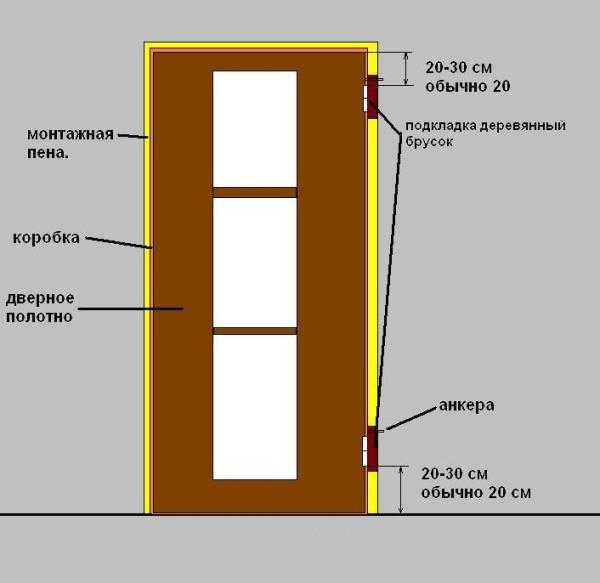
- Weight. For installation in rooms, a too massive structure is not required.
- Sound and heat insulation. The design should not let sounds from the bathroom and noise into the bedroom. Thermal insulation is important for the door to the balcony, but not for the rest.
- Moisture resistance. Important when installing in the bathroom, kitchen or toilet. It is better to take laminated PVC.
- Design. The type and number of leaves, the structure of the leaf and the presence of inserts are selected based on practical requirements.
On the video you can see the selection rules:
- Finishing. It must meet the requirements of design and durability.
- Colors and style. The choice of color, structure and pattern is determined by design requirements and personal taste preferences. The product should match the style of the interior as much as possible.
In any case, it is correct to start the choice by measuring the opening. It is difficult to take into account all tolerances, allowances, therefore it is recommended to provide work to specialists. They should also set. Doors are best ordered from trusted manufacturers in the catalog. The store checks the completeness and build quality, the availability of a guarantee. Attention is drawn to the quality of fittings, decorative elements and locks, as well as the actual condition of the surfaces. The advice of experts and friends is always worth taking into account.
